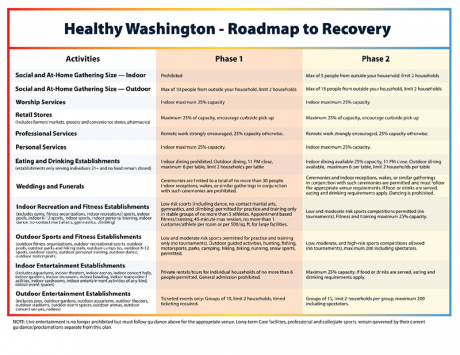Inslee’s Phased COVID Recovery Plan
Posted January 5, 2021 at 9:56 pm by Hayley Day
From Gov. Inslee’s Office
On Jan. 5, Gov. Jay Inslee announced “Healthy Washington — Roadmap to Recovery,” a COVID-19 phased recovery plan.
Beginning on Jan. 11, the state will follow a regional recovery approach with every region beginning in Phase 1.
“No one was untouched by the effects of the pandemic in 2020; many have and continue to suffer through no fault of their own,” Inslee said during a press conference Tuesday. “We aren’t out of this yet, but we are close to turning the corner on COVID-19 and this third wave of infection.”
Washington has avoided overwhelming the state’s health care systems throughout this pandemic so far through rigorous safety measures, such as physical distancing and masking, as well as social and economic restrictions.
This new recovery system aims to safely ease some restrictions while also maintaining crucial hospital capacity, ensuring care for Washingtonians that need it and paving the way for economic recovery.
Regions
The regions are mostly based on Emergency Medical Services regions used for evaluating healthcare services. There will be eight regions of four or more counties, divided according to available health care services based on metrics such as hospitalizations, case data and disease mobility.
The eight regions are as follows:
- Central: King, Pierce, Snohomish
- East: Adams, Asotin, Ferry, Garfield, Lincoln, Pend Oreille, Spokane, Stevens, Whitman
- North: Island, San Juan, Skagit, Whatcom
- North Central: Chelan, Douglas, Grant, Okanogan
- Northwest: Clallam, Jefferson, Kitsap, Mason
- South Central: Benton, Columbia, Franklin, Kittitas, Walla Walla, Yakima
- Southwest: Clark, Cowlitz, Klickitat, Skamania, Wahkiakum
- West: Grays Harbor, Lewis, Pacific, Thurston
“Our intent is to ensure that regions, the communities within them, and our state as a whole have a balanced path toward recovery from the pandemic that relies on multiple key metrics that look at disease trajectory and health system capacity,” said Deputy Secretary for COVID Response Lacy Fehrenbach. “This plan offers the start of a clear way forward as we continue to slow the spread of COVID-19, while we get more people vaccinated over the next few months.”
Metrics
A region’s phase will be determined by the Department of Health in response to four metric requirements.
The final metrics for regions will be calculated on Friday, Jan. 8 and will be effective Jan. 11.
To go forward from Phase 1 to Phase 2, regions must meet all four metrics:
- Decreasing trend in two-week rate of COVID-19 cases per 100K population (decrease >10%)
- Decreasing trend in two-week rate new COVID-19 hospital admission rates per 100K population (decrease >10%)
- ICU occupancy (total — COVID-19 and non-COVID-19) of less than 90%
- COVID-19 test positivity rate of <10%
To remain in Phase 2, regions must meet at least 3 metrics:
- Decreasing or flat trend in two-week rate of COVID-19 cases per 100K population
- Decreasing or flat trend in two-week rate new COVID-19 hospital admission rates per 100K population
- ICU occupancy (total — COVID-19 and non-COVID-19) of less than 90%
- COVID-19 test positivity rate of <10%.
- Regions that fail to meet two or more of the above metrics will be moved back to Phase 1.
The metrics for each region will be updated on the Risk Assessment Dashboard every Friday. Dependent on a region’s metrics, DOH will move into a new phase — forward or backward — the following Monday.
DOH and local health departments reserve the right to move a region outside of this timing, and additional phases may be added as the state’s COVID-19 situation changes with continued vaccine distribution and other changes in public health response.
“Our goal is to reopen our economy safely and to do it as quickly as possible. Every week, we plan on tracking our ongoing progress in protecting our communities against COVID-19,” said Secretary of Health Umair Shah. “The governor’s new plan will allow all of us to understand what measures are being used for the path forward including when it makes sense to ease restrictions across the state.”
You can support the San Juan Update by doing business with our loyal advertisers, and by making a one-time contribution or a recurring donation.
Categories: Health & Wellness, Safety











No comments yet. Be the first!
By submitting a comment you grant the San Juan Update a perpetual license to reproduce your words and name/web site in attribution. Inappropriate, irrelevant and contentious comments may not be published at an admin's discretion. Your email is used for verification purposes only, it will never be shared.